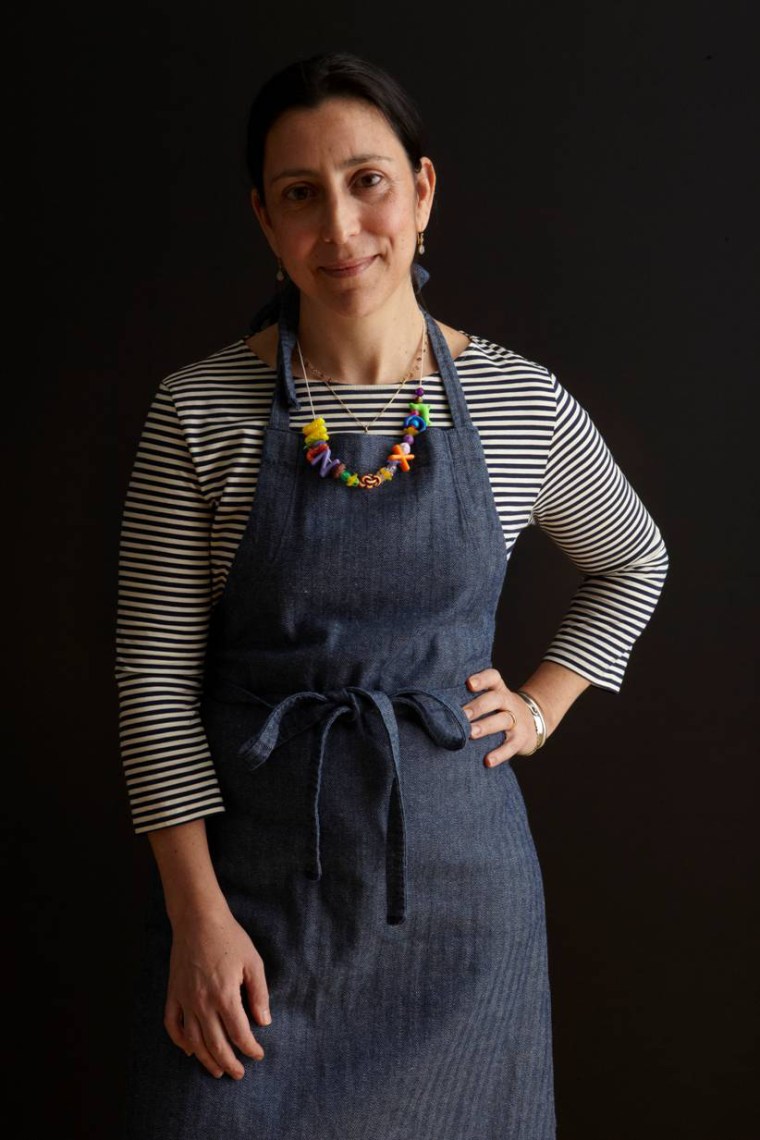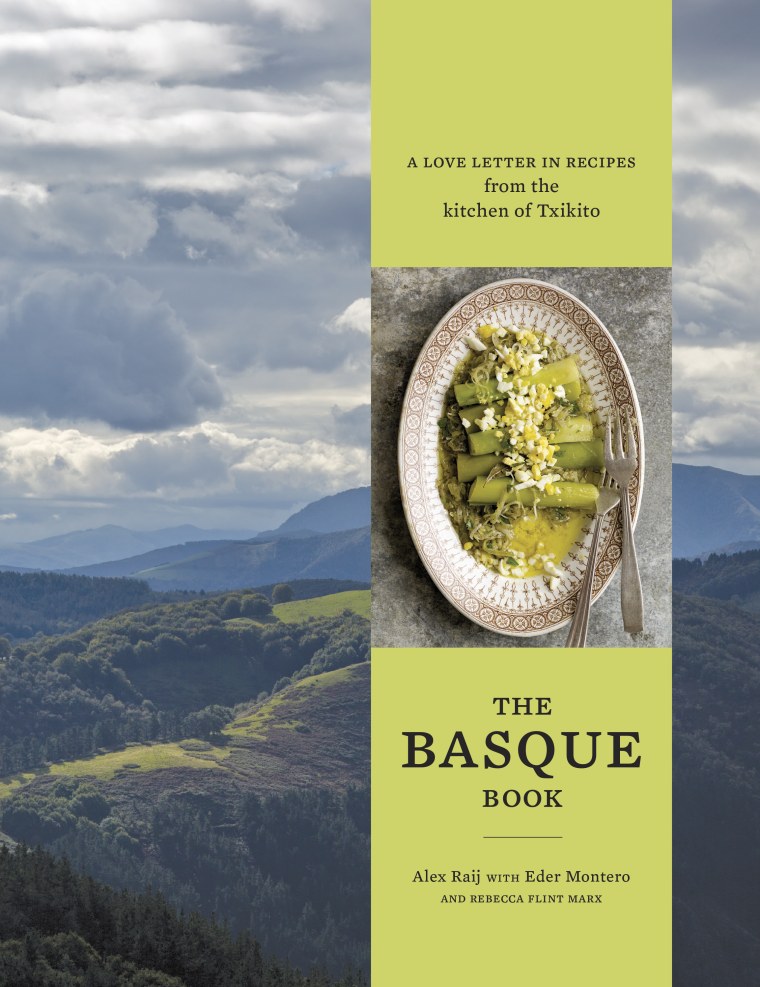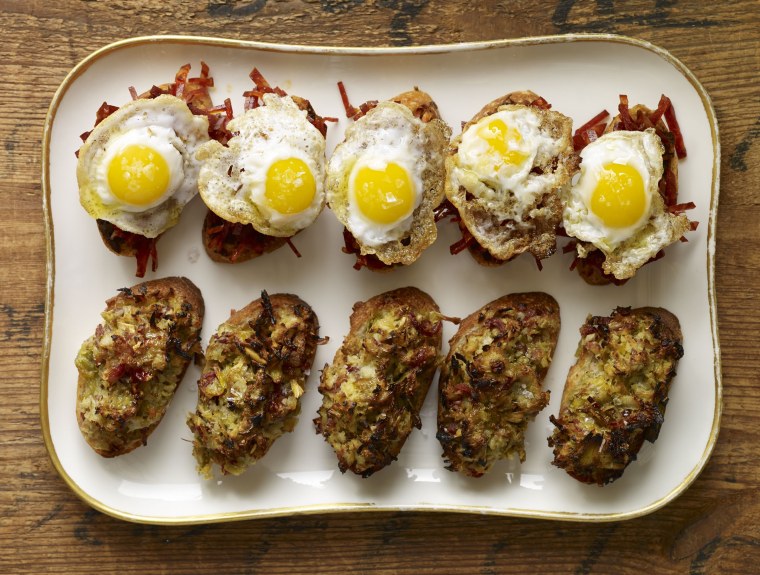There’s a moment when you get to the end of the The Basque Book: A Love Letter in Recipes from the Kitchen of Txikito where you expect the credits to roll. Alexandra Raij and Eder Montero my be the highly regarded chefs and restaurateurs behind New York City’s Txikito, El Quinto Pino and La Vara, but their newly released cookbook has all the makings of a great 1990s rom-com.

As Raij describes her first encounter with Montero in the kitchen of the Basque-Galician restaurant she’d been hired to work in shortly after graduating from culinary school, he was a cocky kid and self-described “real pain in the ass” and she was an assiduous note taker.
“When I met him, I was so taken with him because he’s somebody who can make everyone like him and want to do this very demanding job to please him,” remembers Raij. “It’s something to see and pretty remarkable. He’s got some kind of magic, I don't know what it is.”
At some point, a mylar ballon featuring Pepé le Pew was exchanged, they married, and three restaurants and two children later, they have this wonderful book to show for it.
RELATED: "The Cuban Table": A Savory Trip Through Cuba, Miami And NY
Written with Rebecca Flint Marx and beautifully photographed by Penny de los Santos, the recipes inhabit that remarkable space carved out by Basque cooking where flawless technique is applied to rustic, simple ingredients to produce the hyper-refined cuisine that has captured the food world’s imagination. I caught up with Raij to talk how it all came about.
When you’re reading the book, it’s impossible to separate your relationship with Eder from your relationship to Basque food and how you work together. Who did you fall in love with first - the man or his cooking?
The man, but it was the way he did what he did. He’s a very different cook than me. He won’t mind me saying, because has a lot of intellect, but he’s not an intellectual cook in that way. He’s not questioning. His connection to food is visceral and emotional. He doesn’t think about where dishes come from or how they move across landscapes. For him, dishes are mutually exclusive. What he likes are kitchens - running them, mentoring, and the relationships you establish in a kitchen. He loves that, and he’s really good at it.

You were born and raised in Minnesota to Argentinian parents. When did you first encounter Spanish or Basque cuisine?
Being Argentine, that’s what you grew up with — a lot of Galician influence, a lot of paellas made with long grain rice, variations on arroz con pollo, lots of cazuela de mariscos. All these things that could live comfortably in the Spanish vernacular but were executed in ways that deviated from what you’d find in Spain. There was also this person in my life, whom we called El Vasco, who was an exceptional home cook and loved sharing food. He would sometimes take apart a pig and make head cheese. He would do all kinds of crazy food projects. This was in the seventies and not like now where people do this kind of stuff all the time. He died really young and he was my dad’s best friend, so there are a million emotional reasons why he is a big figure for me.
It was a time where my parents were socializing a lot in Spanish which was my first language. There came a time where that stopped being true and their communities became about geography or work instead being a Spanish speaker. Maybe I associate a lot of my youth and the emotional value of food with these characters, who were all speaking in Spanish. When I met Eder, I started conducting my life in Spanish again.
Why do you think Spanish food in general and Basque food in particular has finally gained recognition in the United States?
When we opened [our first restaurant], the whole point was to set new standards for Spanish food and choose new dishes to represent Spain that weren’t the active dishes at the time. We purposely didn’t make paella because we didn’t want people to connect what we were doing to the lack of quality that was in the marketplace before. I think it was [also] the tapas tradition and access to better, authentic Spanish products. When you were able to get Serrano jam it kind of blew prosciutto out of the water. Also, people become very interested in a lower cuisine when there’s a high cuisine, so the alta cocina brought interest to the region.

You describe Basque cooking as a cuisine of subtraction. Are there any particular recipes you feel best illustrate this?
One of the most iconic dishes is bakalao al pil pil. You take the salt cod and soak it until it’s at the level of saltiness that you want, then after you’ve taken most of the water content out of it, you poach or confit it in garlic and olive oil and you use that same oil to produce a sauce of supreme elegance. It’s so minimalist. You’re recovering the juice the salt weeps out during the process of poaching and you’re mixing it with the oil you actually poached it in, and that’s your sauce. The garlic you used to flavor the oil goes on top if you’re so inclined. It’s a technique that opens up your whole world because once you see that percolation with the other ingredients you’re "confiting" you think what other pil pil can I make?
RELATED: 5 Classic Latino Cookbooks for Mother's Day
Many of the recipes rely on using the best possible ingredients and you include a lot of fundamentals in the book. How can you achieve this in your home?
One of the greatest joys was not having access to those ingredients and having to make them ourselves or finding those substitutes. In the process, we were behaving in a more Basque way. Hopefully, now we can tell people how to produce certain things. I don’t make my own anchovies, but I do make my own boquerones sometimes. You can buy them now but when you couldn’t, we would make them. That’s also the most satisfying part about working in a cuisine where not everything is available, because you really had to teach yourself. I’ve always called Basque ingredients very few but very elastic. It’s just garlic and olive oil over and over again but, for some reason, the number of dishes and their uniqueness, is how you weave them together.
Here are three amazing recipes from The Basque Book: A Love Letter in Recipes from the Kitchen of Txikito.
